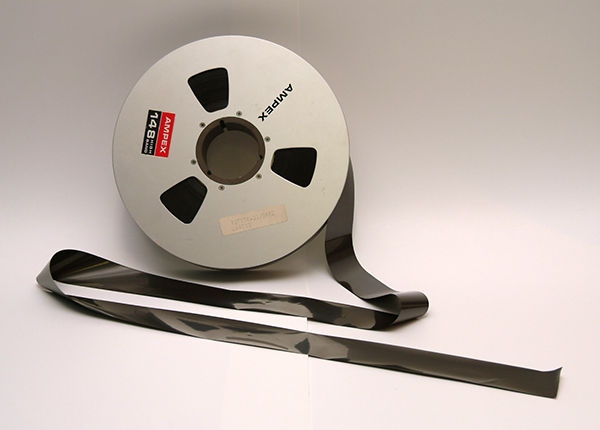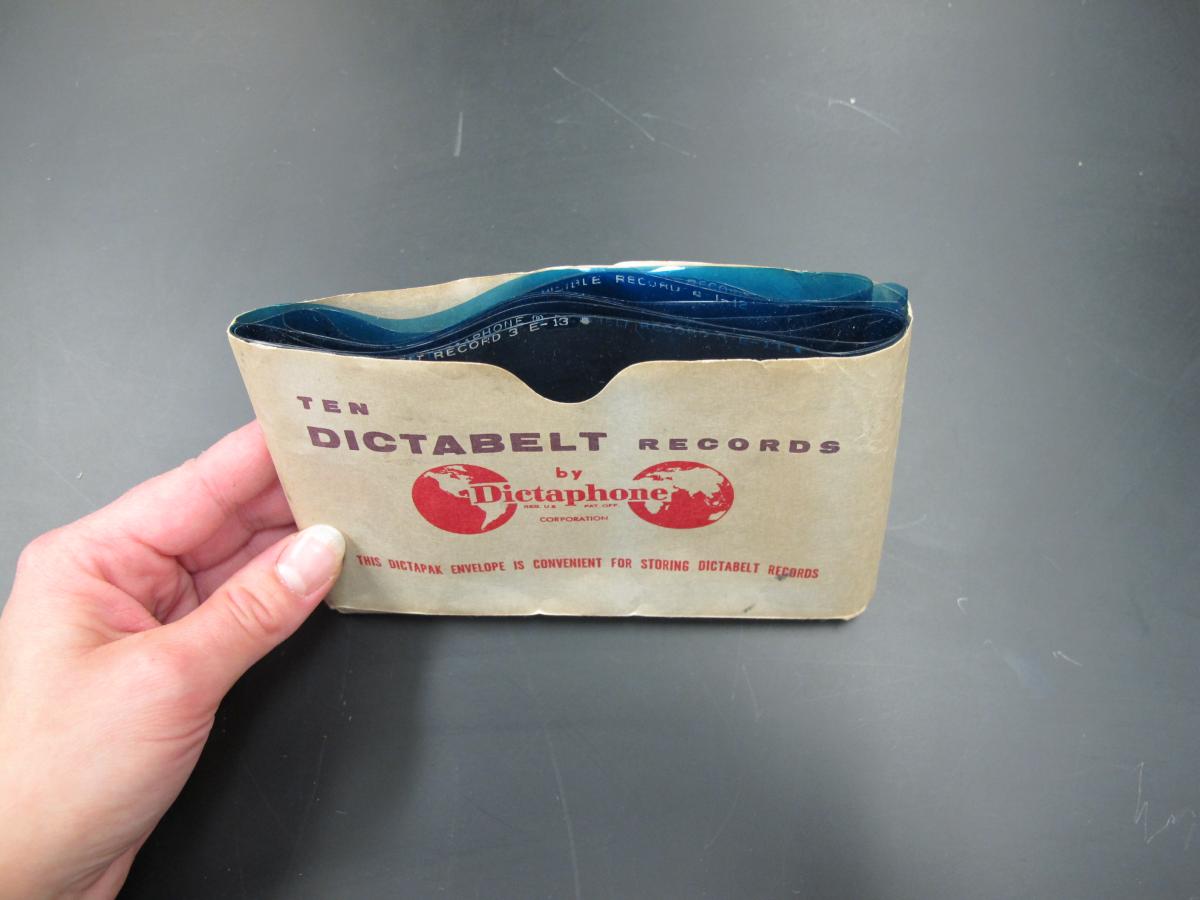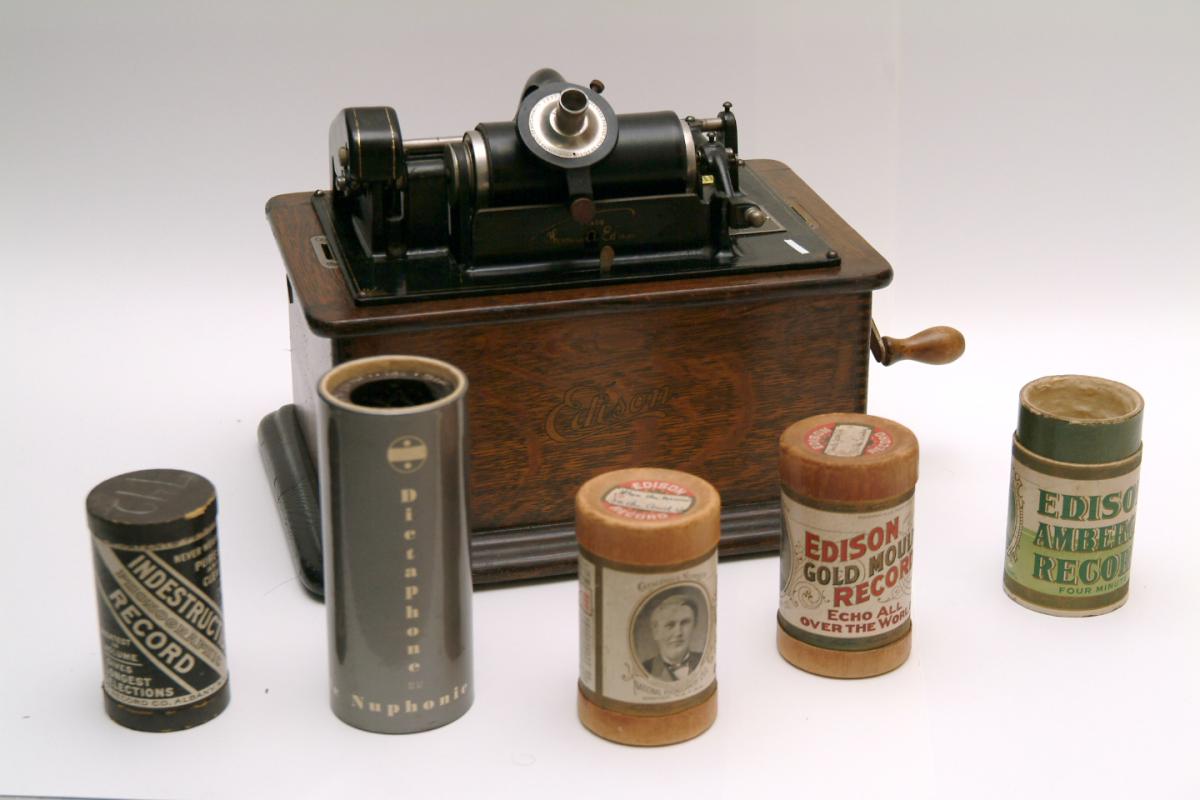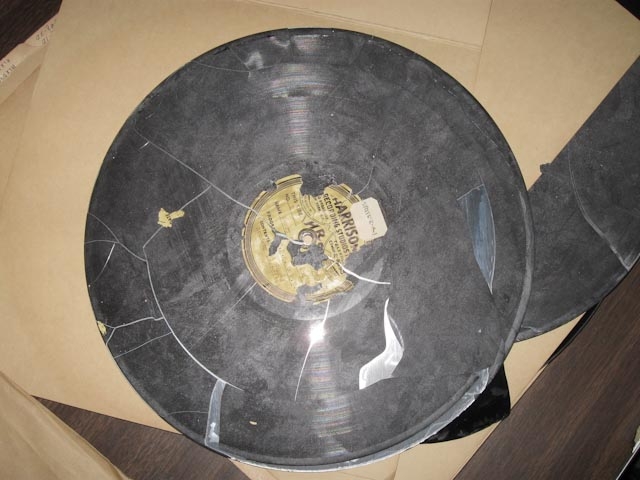
Machine-Readable Media
Known also as electronic media or dynamic media, these records encompass a variety of formats. This page contains information on the following:
- Magnetic Media: Audio and Video Tapes
- Grooved Sound Recordings
- Optical Discs
- Solid-State Media
- Magnetic Media: Storage
Magnetic Media: Audio and Video Tapes
Magnetic-based audio and video media may be one of the least stable formats found in archival holdings, depending on age, type of tape, and how it has been stored. In addition to deterioration of the media itself, the proper equipment must be available to playback the record. For these reasons, it is recommended that significant and frequently used tapes be copied or reformatted.
Always avoid touching the tape’s surface or the edge of the tape pack. Handle the outside of a cassette or cartridge. Carry individual reels of tape by the hub, or center.
If you must handle the tape itself, wear gloves and handle tape and leaders gently without tension or contortion. Do not let tape dangle over edges or touch the floor.
Store each tape in a storage box to protect it from dust and pollutants, and to buffer against high humidity and temperature changes.
- If resources allow and the original paper cassette is not significant, consider replacing cardstock video covers with inert plastic boxes. Plastic flip-open cassette boxes are recommended for audio tapes. Plastic cassette boxes with snap closures are recommended for video tapes.
- Cartridge boxes should have projections to lock the hubs and prevent them from turning during storage or movement.
- Groups of tapes can be housed in archival paper boxes designed to hold multiple cassettes.
Magnetic tape, especially videotape, is susceptible to dimensional distortions that interfere with playback.
- Store a tape vertically on edge, not flat, so that the tape is supported by the reel hub.
- Avoid dropping a tape cassette.
Keep magnetic tapes away from strong magnetic fields, such as transformers and motors, that may damage the recording. Do not place tapes near or on top of equipment such as loudspeakers or surge protectors.
Never use splicing tape or attempt to repair or splice broken magnetic tape unless you have received appropriate training. Consult an audio-video preservation specialist.
Playing Audio and Video Tapes
Any tape is susceptible to damage in a variety of ways each time it is played.
- Limit the number of times an original tape is played.
- Make certain the tape is wound correctly to its end before removing the tape from the equipment.
- Prioritize reformatting any significant or frequently used tapes.
If the tape is visibly dusty, dirty or has any debris do not play it without seeking guidance from a preservation specialist.
Only use playback equipment appropriate for the format and that is well maintained. This will produce a high-quality recording and minimize damage to the original tape.
- Clean players periodically to prevent scratching the tape or depositing debris on the tape surface.
- Mechanically align recorders to prevent tape damage such as tearing or stretching and to produce tight tape packs.
- Electrically align recorders to prevent signal problems that will result in poor quality recordings.
Play a tape or cassette to the end, leaving the tape wound smoothly with only leader or unrecorded tape exposed. Open reels of tape should have the end fastened with an approved tape or packing which avoids uneven pressure.
Dust, debris from the tape itself, and other deposits can be wound on the reel and cause problems during the next playback.
- Keep the work area clean.
- Include cleaning the machine heads and tape path as part of routine equipment maintenance.
Longevity and Reformatting of Audio and Video Tapes
Because it is difficult to determine the exact formulation of any particular tape, it is recommended that any audio or video magnetic tape be reformatted to preserve its informational content.
- Common audio and audio-video formats such as U-matic, VHS, S-VHS, 8mm, and BetaCam were produced using a variety of binders, substrates, and oxides that created different format types and formulations.
- Magnetic formulation layers may include iron oxide, chromium dioxide, barium ferrite, metal particulate, or metal evaporated. The tape formulation has a significant impact on the stability of the tape; some formulations are very unstable.
- NARA recommends reformatting video tape older than five years, and audio tape older than 15 years. Deteriorating tapes with important content should be prioritized for reformatting.
- Produce several copies of a reformatted audio or video-tape to help ensure preservation of the content. Consider storing copies in multiple locations.
Store magnetic tape in humidity conditions between 30 and 40% relative humidity (RH) to limit moisture that causes binder hydrolysis, or degradation of the binder, which is a significant factor determining the longevity of a tape.
- Higher humidity above 65% can also lead to mold growth.
- If you observe white crystalline deposits or a fuzzy growth on a tape, contact an audio-video preservation specialist.
Store magnetic tape in cooler temperatures between 50-65°F to slow deterioration of the magnetic pigments that record the information.
The substrate used to produce tapes during the 1940s and 1950s is likely to be acetate-based and susceptible to vinegar syndrome.
- Store any tape suspected of deterioration separately from other archival materials and preferably under temperature conditions between 50-65°F to slow the rate of deterioration.
- Do not freeze magnetic based media including audio and video tapes.
For additional information on preserving audio and audio video records see: Audio Guidance and Video Guidance.
Grooved Sound Recordings
LP, Wax Cylinder, Dictabelt, and Others
Grooved sound recordings vary in composition and life expectancy. In addition to deterioration of the media itself, the proper equipment must be available to play back the recording.
(Early equipment used in the playback of grooved sound recordings did not utilize electricity. The mechanism would be powered by hand. Therefore, these early sound recordings are not technically electronic media.)
Because it is difficult to determine the exact formulation of any particular grooved recording, it is recommended that an original recording be reformatted to preserve its informational content.
Handle with gloves and avoid directly touching the surface of the grooved disc recording.
- It is safe to handle most grooved sound recordings by the edges and label areas.
- For wax cylinders, do not touch the outer grooved surface; handle with middle and index fingers inserted into the cylinder.
Avoid flexing the disc or subjecting it to physical shocks such as tapping or dropping a grooved recording.
Cracks in the disc or broken discs or cylinders indicate your media is in a very fragile state.
- Avoid picking up a damaged disc or suspending it in air. Use a piece of cardstock to support the record.
Grooved discs and wax cylinders should be kept in a temperature controlled environment and come to room temperature before handling.
Discs should be stored in sleeves and proper housing. If possible, wax cylinders should be removed from original cardboard housing and placed in an archival box fit appropriately to keep it safe.
Shelve discs or cylinders vertically and in their sleeves/housing to protect them.
- This will help avoid preservation issues such as warping or breakage
- Do not stack discs on top of one another.
Playing Grooved Sound Recordings
Any grooved recording is susceptible to damage in a variety of ways each time it is played.
Limit the number of times an original recording is played.
Consider reformatting any grooved recording with original content. Prioritize reformatting any significant or frequently used recordings
If the grooved recording is visibly dusty, dirty, appears warped, or has a white oily sheen, do not play it without seeking guidance from a preservation specialist.
- If a grooved disc or wax cylinder is cracking, bubbling, or peeling, it may be suffering from delamination. Loss of information may be irreversible.
- A powdery white substance that appears to grow or spread on a recording may indicate the presence of mold of fungus. This may destroy the grooves of your media if not attended to immediately by a preservation specialist.
- Deposits of white material on the surface of an aluminum disc may indicate oxidation. Cleaning may do more harm: please seek advice from a preservation specialist.
Only use playback equipment and styli appropriate for the format and that is well maintained. This will produce a high-quality recording and prevent damaging the original recording.
In general, laminated discs tend to deteriorate more quickly than aluminum discs, LPs/45s, and wax cylinders, which can possibly last for generations if kept under favorable conditions and handled well.
Other types of grooved recordings you may encounter include dictablets and soft plastic discs such as the SoundScriber or Audograph disc. Grooved recordings consist of different chemical make-ups depending on when they were produced.
- Cellulose acetate and nitrate bases cause most preservation issues. When oxidation reacts with the acids (acetic or nitric), discs run the risk of becoming very brittle.
- In acetate discs, the loss of castor oil plasticizer over time causes shrinkage and, in turn, peeling of the coating. The lacquer coating may start to crack, bubble, or flake off the disc as well. This is known as delamination. A white oily sheen may indicate the presence of palmitic acid, the first step towards delamination
- Discs that have glass substrates are extremely fragile and prone to breakage.
- Depending on the chemical makeup of the grooved recordings collections, there are many other factors you may encounter at home or in a professional environment.
- The plastic from a dictablet may become brittle over time, and if there are any creases from improper storage they may become permanent.
- Soft plastic discs may require groove evaluation prior to attempted playback. They come in a variety of formats such as Audograph, SoundScriber, Edison Voicewriters, and Flexi discs.
Longevity and Reformatting of Grooved Sound Recordings
Store grooved recordings in humidity conditions between 30 and 40% relative humidity (RH) to limit moisture that causes binder hydrolysis, or degradation of the binder, which is a significant factor determining the longevity of a tape.
- Higher humidity above 65% can also lead to mold growth.
- Grooved recordings should be kept away from sources of heat, including sunlight or room lighting.
- If you observe a white oily sheen or a fuzzy growth on a grooved recording, contact an audio-video preservation specialist.
For additional information on preserving grooved recordings see: Audio Guidance and the Grooved Recordings Condition Assessment.
Optical Discs
Many types of optical discs, such as LaserDiscs, compact discs (CDs), digital video discs (DVDs), and Blu-Ray discs, are unstable and present long-term preservation challenges. Holdings maintenance includes proper storage, but should also assess the need to reformat content.
Avoid touching the media data surface. Handle a disc with nitrile or cotton gloves along the outer edge and center hole. Do not flex the disc.
Dust, grit, fingerprints, other deposits, and scratches on the data surface can interfere with the laser reading the disc.
- Remove loose dust very gently with an air puffer bulb traditionally used for photographs.
- If fingerprints or similar deposits are visible on the media surface, clean by wiping with a dry, lint-free soft cloth, moving from the center of the disc straight out to the edge. If necessary, deionized or distilled water can be used, but allow the disc to dry completely before storing it in a case or attempting to play it.
Small, occasional scratches are unlikely to affect readability.
- There is no holdings maintenance procedure that can correct scratches deep enough to affect readability.
- Scratches running circularly around the disc are more damaging than those running across from the center hole towards the outer edge, so never wipe around the disc in a circular motion.
Store each individual disc upright (vertical), not flat (horizontal), in a plastic jewel case. Polypropylene cases are preferred.
- The jewel case will protect the disc from dust and is designed to hold the media surface away from contact with the case.
- Place one CD or DVD in a case, using additional cases if necessary.
- Avoid flexing or bending the disc, even slightly. When removing a disc from its case, press down on the hub tab on the case while holding the outer edge of the disc with several fingers and lift up. Do not flex the disc to remove it.
- Consider removing paper inserts found inside a case and storing them separately with appropriate cross-references. The paper and inks may damage the media over time.
Avoid marking on the disc; label the container whenever possible.
- If you must label the disc, mark in the clear inner hub using a non-solvent or water-based felt tip marker. Any solvent may affect the protective coating on the disc. The soft felt tip is unlikely to scratch the fragile surface.
- Do not add a new adhesive label to a disc, or attempt to peel off or reposition an existing label.
For more information, please see: Care and Handling of CDs and DVDs.
Solid-State Media
Solid-state media such as solid-state drives, USB flash drives, and digital camera memory cards are entirely solid with no moving parts. Life expectancies can vary based on the amount of use, and may last only a few years. It is recommended to copy content into a current storage environment as soon as possible.
Handling solid-state media
- Handle by the edges.
Storing solid-state media:
- Store flat in enclosures and keep caps on the ends of USB drives.
- Use inert polyester enclosures where possible.
- Avoid extreme temperatures, humidity, sunlight, and dust.
Consult with an electronic records specialist.
Magnetic Media: Storage
Magnetic storage media such as floppy disks (flexible and cartridge) and spinning disk hard drives have been widely used for storing data. Due to varied life expectancies and availability of equipment to read back the media, it is recommended to copy content into a current storage environment as soon as possible.
Handling electronic magnetic media:
- Avoid touching the magnetic recording surface; handle by the edges.
- Do not attempt to open floppy disks (either flexible or cartridge).
- Do not attempt to reposition the write-protect switch on floppy disks..
- Avoid marking on the media; label the container whenever possible.
- If you must label a floppy disk, mark on the label area only.
Storing electronic magnetic media
- Store each individual floppy or Zip disk upright (vertical), not flat (horizontal). Use inert plastic enclosures where possible.
- Keep magnetic media away from strong magnetic fields, such as transformers and motors, that may damage the recording. Do not place media near or on top of equipment such as loudspeakers or surge protectors.
- Avoid extreme temperatures, humidity, sunlight, and dust.
- Allow at least 24 hours for media to acclimate to room temperature and relative humidity before use.
Magnetic Data Tapes:
Magnetic data tapes such as Linear Tape-Open (LTO), 9-track, Digital Linear Tape (DLT), and 3480 tape are magnetic tapes that store digital information. Magnetic data tapes are now commonly housed in cartridges or cassettes, but used to be on open reels. Data tapes are frequently used for system backups and long-term storage due to their low cost and high storage density; however, like other magnetic formats they must be routinely migrated.
NARA randomly samples magnetic data tapes annually to check for readability.
See the Audio and Videotape Formats for additional guidance on handling and storage.



